Investigating T&D Impact on Employee Performance: A Sainsbury's Study
VerifiedAdded on 2023/06/08
|17
|5693
|281
Report
AI Summary
This report presents a comprehensive analysis of the impact of training and development (T&D) on employee performance, specifically within the UK retail sector, with a focus on Sainsbury's. The report is divided into two main tasks: a project proposal outlining the research topic, aims, objectives, research questions, key areas, literature review, research methodology, and timeline; and a project report that expands on these aspects. The report delves into the concept of T&D, exploring various models such as on-the-job and off-the-job training. It identifies different T&D sessions employed by the retail industry, including sales training, customer service training, and leadership skills programs. The research examines the relationship between T&D and employee performance within Sainsbury's, considering its market share, employee count, and various training initiatives. The report employs a qualitative research approach, utilizing secondary data sources to evaluate the impact of T&D and offer recommendations for improving employee performance, concluding with reflections, recommendations, and conclusions based on the findings.

TASK 1 & 2
Paraphrase This Document
Need a fresh take? Get an instant paraphrase of this document with our AI Paraphraser
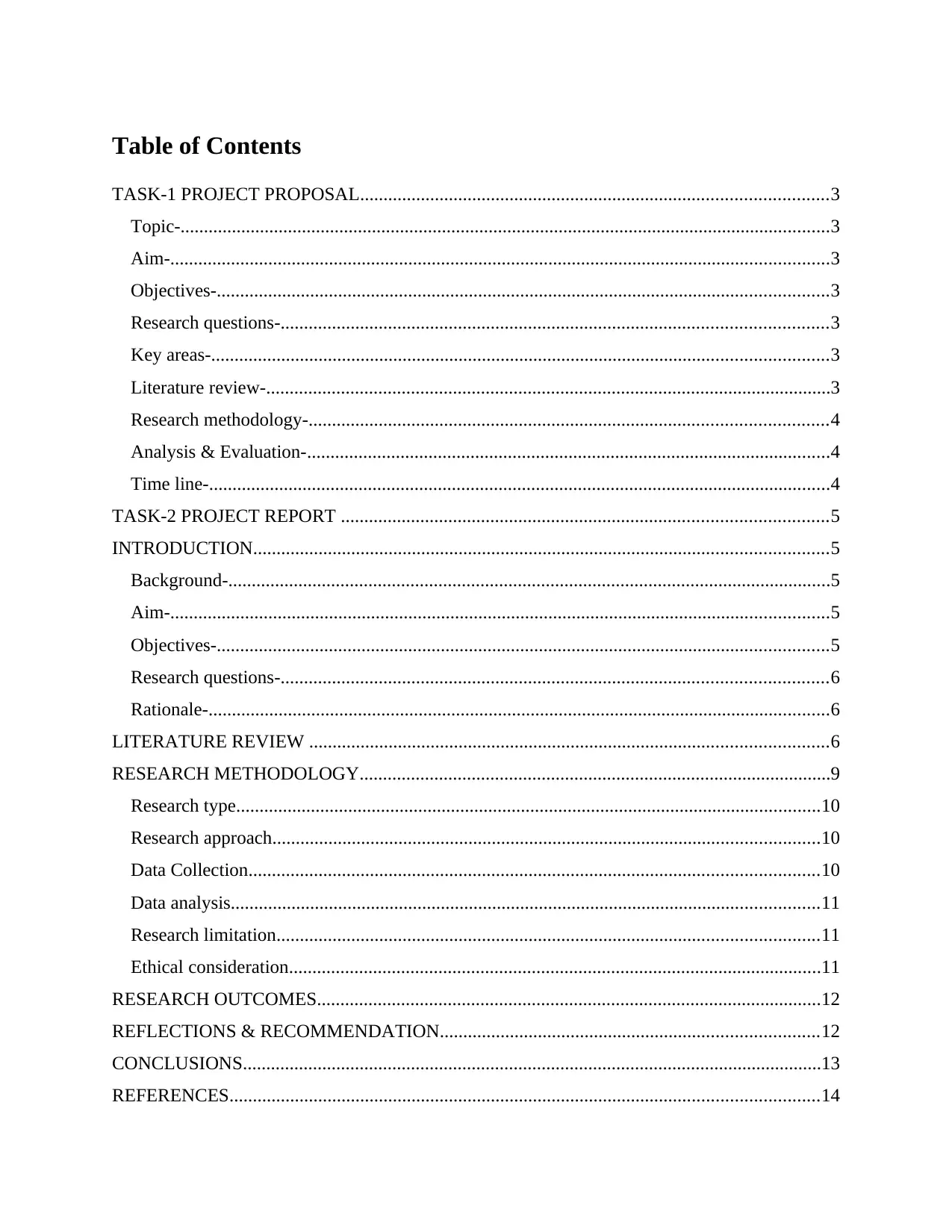
Table of Contents
TASK-1 PROJECT PROPOSAL....................................................................................................3
Topic-...........................................................................................................................................3
Aim-.............................................................................................................................................3
Objectives-...................................................................................................................................3
Research questions-.....................................................................................................................3
Key areas-....................................................................................................................................3
Literature review-.........................................................................................................................3
Research methodology-...............................................................................................................4
Analysis & Evaluation-................................................................................................................4
Time line-.....................................................................................................................................4
TASK-2 PROJECT REPORT ........................................................................................................5
INTRODUCTION...........................................................................................................................5
Background-.................................................................................................................................5
Aim-.............................................................................................................................................5
Objectives-...................................................................................................................................5
Research questions-.....................................................................................................................6
Rationale-.....................................................................................................................................6
LITERATURE REVIEW ...............................................................................................................6
RESEARCH METHODOLOGY.....................................................................................................9
Research type.............................................................................................................................10
Research approach.....................................................................................................................10
Data Collection..........................................................................................................................10
Data analysis..............................................................................................................................11
Research limitation....................................................................................................................11
Ethical consideration..................................................................................................................11
RESEARCH OUTCOMES............................................................................................................12
REFLECTIONS & RECOMMENDATION.................................................................................12
CONCLUSIONS............................................................................................................................13
REFERENCES..............................................................................................................................14
TASK-1 PROJECT PROPOSAL....................................................................................................3
Topic-...........................................................................................................................................3
Aim-.............................................................................................................................................3
Objectives-...................................................................................................................................3
Research questions-.....................................................................................................................3
Key areas-....................................................................................................................................3
Literature review-.........................................................................................................................3
Research methodology-...............................................................................................................4
Analysis & Evaluation-................................................................................................................4
Time line-.....................................................................................................................................4
TASK-2 PROJECT REPORT ........................................................................................................5
INTRODUCTION...........................................................................................................................5
Background-.................................................................................................................................5
Aim-.............................................................................................................................................5
Objectives-...................................................................................................................................5
Research questions-.....................................................................................................................6
Rationale-.....................................................................................................................................6
LITERATURE REVIEW ...............................................................................................................6
RESEARCH METHODOLOGY.....................................................................................................9
Research type.............................................................................................................................10
Research approach.....................................................................................................................10
Data Collection..........................................................................................................................10
Data analysis..............................................................................................................................11
Research limitation....................................................................................................................11
Ethical consideration..................................................................................................................11
RESEARCH OUTCOMES............................................................................................................12
REFLECTIONS & RECOMMENDATION.................................................................................12
CONCLUSIONS............................................................................................................................13
REFERENCES..............................................................................................................................14
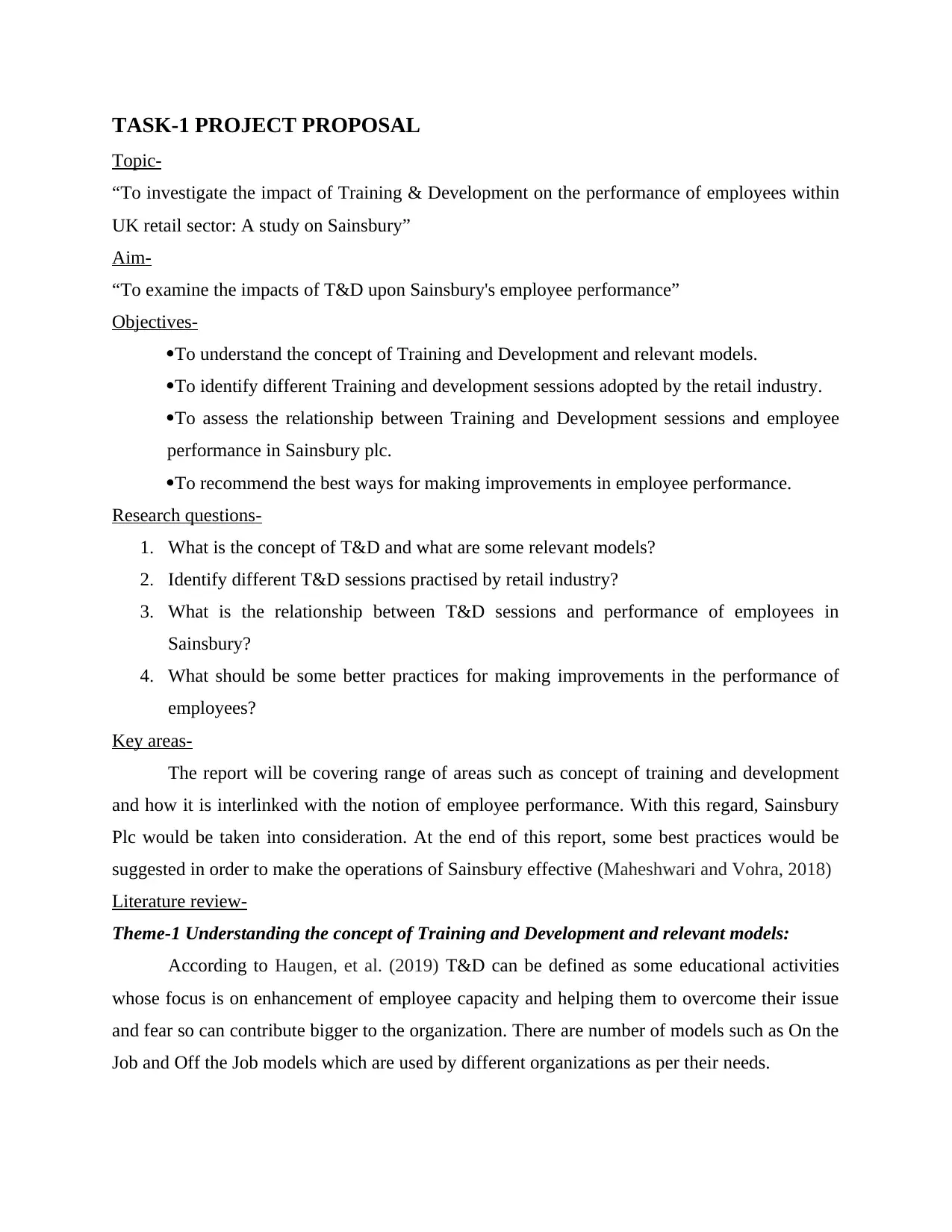
TASK-1 PROJECT PROPOSAL
Topic-
“To investigate the impact of Training & Development on the performance of employees within
UK retail sector: A study on Sainsbury”
Aim-
“To examine the impacts of T&D upon Sainsbury's employee performance”
Objectives-
To understand the concept of Training and Development and relevant models.
To identify different Training and development sessions adopted by the retail industry.
To assess the relationship between Training and Development sessions and employee
performance in Sainsbury plc.
To recommend the best ways for making improvements in employee performance.
Research questions-
1. What is the concept of T&D and what are some relevant models?
2. Identify different T&D sessions practised by retail industry?
3. What is the relationship between T&D sessions and performance of employees in
Sainsbury?
4. What should be some better practices for making improvements in the performance of
employees?
Key areas-
The report will be covering range of areas such as concept of training and development
and how it is interlinked with the notion of employee performance. With this regard, Sainsbury
Plc would be taken into consideration. At the end of this report, some best practices would be
suggested in order to make the operations of Sainsbury effective (Maheshwari and Vohra, 2018)
Literature review-
Theme-1 Understanding the concept of Training and Development and relevant models:
According to Haugen, et al. (2019) T&D can be defined as some educational activities
whose focus is on enhancement of employee capacity and helping them to overcome their issue
and fear so can contribute bigger to the organization. There are number of models such as On the
Job and Off the Job models which are used by different organizations as per their needs.
Topic-
“To investigate the impact of Training & Development on the performance of employees within
UK retail sector: A study on Sainsbury”
Aim-
“To examine the impacts of T&D upon Sainsbury's employee performance”
Objectives-
To understand the concept of Training and Development and relevant models.
To identify different Training and development sessions adopted by the retail industry.
To assess the relationship between Training and Development sessions and employee
performance in Sainsbury plc.
To recommend the best ways for making improvements in employee performance.
Research questions-
1. What is the concept of T&D and what are some relevant models?
2. Identify different T&D sessions practised by retail industry?
3. What is the relationship between T&D sessions and performance of employees in
Sainsbury?
4. What should be some better practices for making improvements in the performance of
employees?
Key areas-
The report will be covering range of areas such as concept of training and development
and how it is interlinked with the notion of employee performance. With this regard, Sainsbury
Plc would be taken into consideration. At the end of this report, some best practices would be
suggested in order to make the operations of Sainsbury effective (Maheshwari and Vohra, 2018)
Literature review-
Theme-1 Understanding the concept of Training and Development and relevant models:
According to Haugen, et al. (2019) T&D can be defined as some educational activities
whose focus is on enhancement of employee capacity and helping them to overcome their issue
and fear so can contribute bigger to the organization. There are number of models such as On the
Job and Off the Job models which are used by different organizations as per their needs.
⊘ This is a preview!⊘
Do you want full access?
Subscribe today to unlock all pages.

Trusted by 1+ million students worldwide
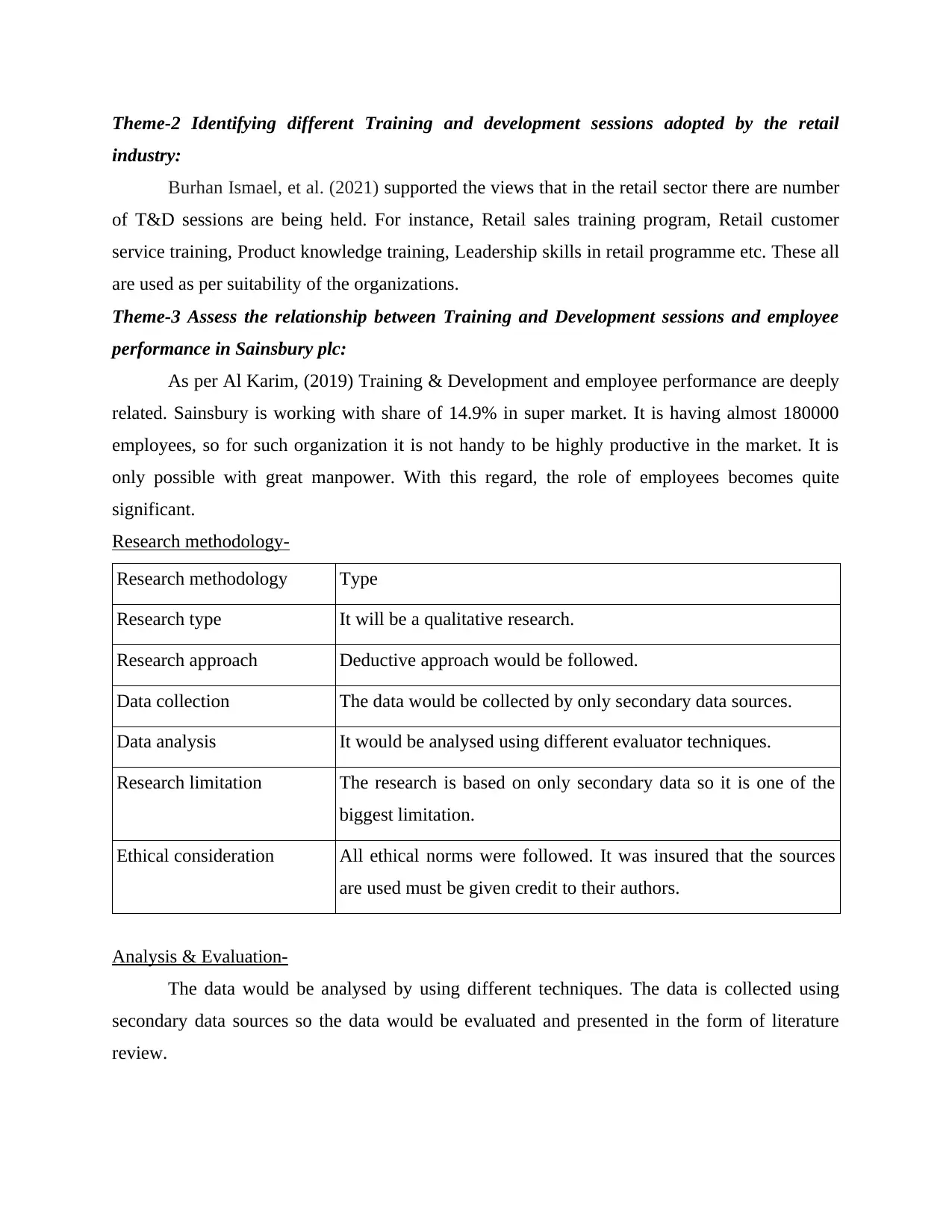
Theme-2 Identifying different Training and development sessions adopted by the retail
industry:
Burhan Ismael, et al. (2021) supported the views that in the retail sector there are number
of T&D sessions are being held. For instance, Retail sales training program, Retail customer
service training, Product knowledge training, Leadership skills in retail programme etc. These all
are used as per suitability of the organizations.
Theme-3 Assess the relationship between Training and Development sessions and employee
performance in Sainsbury plc:
As per Al Karim, (2019) Training & Development and employee performance are deeply
related. Sainsbury is working with share of 14.9% in super market. It is having almost 180000
employees, so for such organization it is not handy to be highly productive in the market. It is
only possible with great manpower. With this regard, the role of employees becomes quite
significant.
Research methodology-
Research methodology Type
Research type It will be a qualitative research.
Research approach Deductive approach would be followed.
Data collection The data would be collected by only secondary data sources.
Data analysis It would be analysed using different evaluator techniques.
Research limitation The research is based on only secondary data so it is one of the
biggest limitation.
Ethical consideration All ethical norms were followed. It was insured that the sources
are used must be given credit to their authors.
Analysis & Evaluation-
The data would be analysed by using different techniques. The data is collected using
secondary data sources so the data would be evaluated and presented in the form of literature
review.
industry:
Burhan Ismael, et al. (2021) supported the views that in the retail sector there are number
of T&D sessions are being held. For instance, Retail sales training program, Retail customer
service training, Product knowledge training, Leadership skills in retail programme etc. These all
are used as per suitability of the organizations.
Theme-3 Assess the relationship between Training and Development sessions and employee
performance in Sainsbury plc:
As per Al Karim, (2019) Training & Development and employee performance are deeply
related. Sainsbury is working with share of 14.9% in super market. It is having almost 180000
employees, so for such organization it is not handy to be highly productive in the market. It is
only possible with great manpower. With this regard, the role of employees becomes quite
significant.
Research methodology-
Research methodology Type
Research type It will be a qualitative research.
Research approach Deductive approach would be followed.
Data collection The data would be collected by only secondary data sources.
Data analysis It would be analysed using different evaluator techniques.
Research limitation The research is based on only secondary data so it is one of the
biggest limitation.
Ethical consideration All ethical norms were followed. It was insured that the sources
are used must be given credit to their authors.
Analysis & Evaluation-
The data would be analysed by using different techniques. The data is collected using
secondary data sources so the data would be evaluated and presented in the form of literature
review.
Paraphrase This Document
Need a fresh take? Get an instant paraphrase of this document with our AI Paraphraser
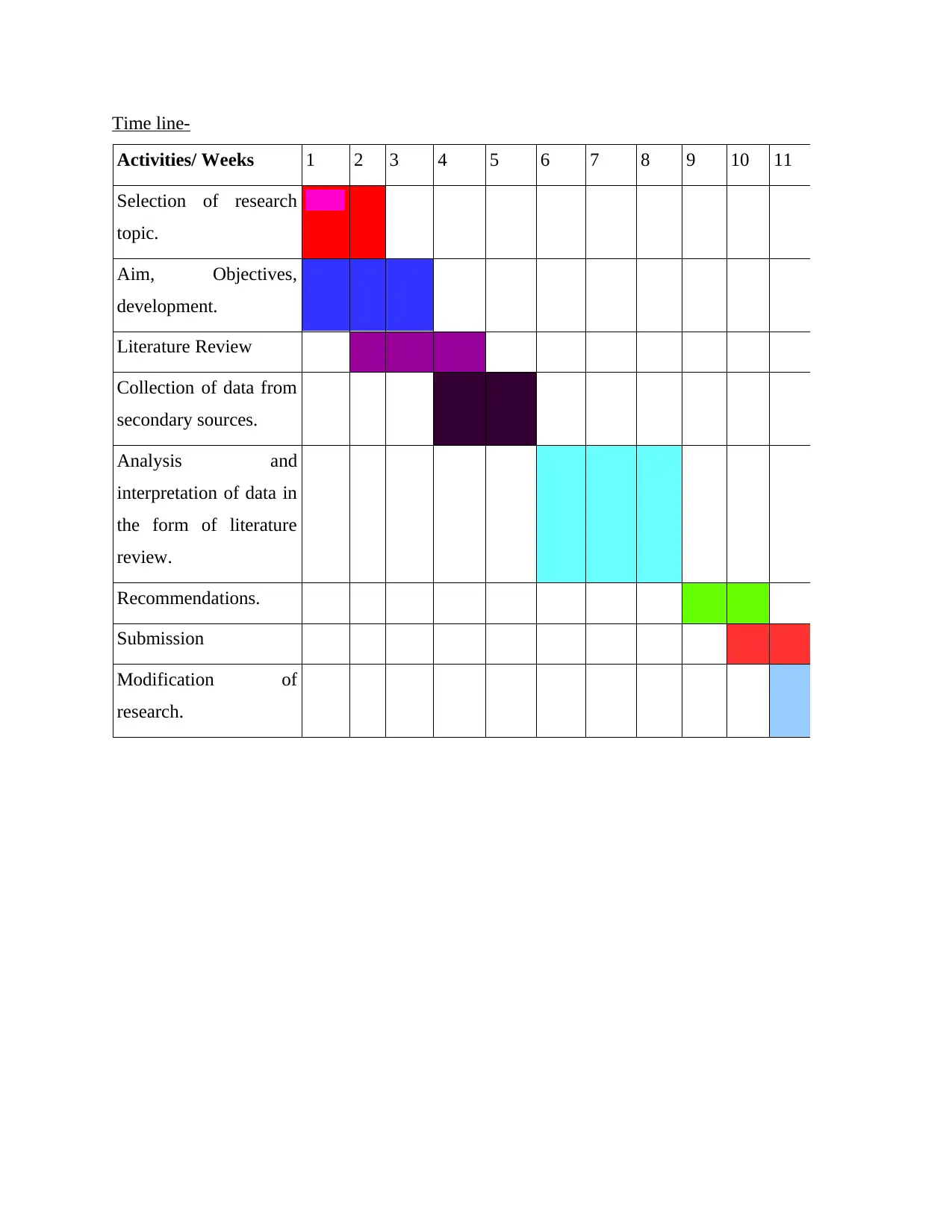
Time line-
Activities/ Weeks 1 2 3 4 5 6 7 8 9 10 11
Selection of research
topic.
Aim, Objectives,
development.
Literature Review
Collection of data from
secondary sources.
Analysis and
interpretation of data in
the form of literature
review.
Recommendations.
Submission
Modification of
research.
Activities/ Weeks 1 2 3 4 5 6 7 8 9 10 11
Selection of research
topic.
Aim, Objectives,
development.
Literature Review
Collection of data from
secondary sources.
Analysis and
interpretation of data in
the form of literature
review.
Recommendations.
Submission
Modification of
research.
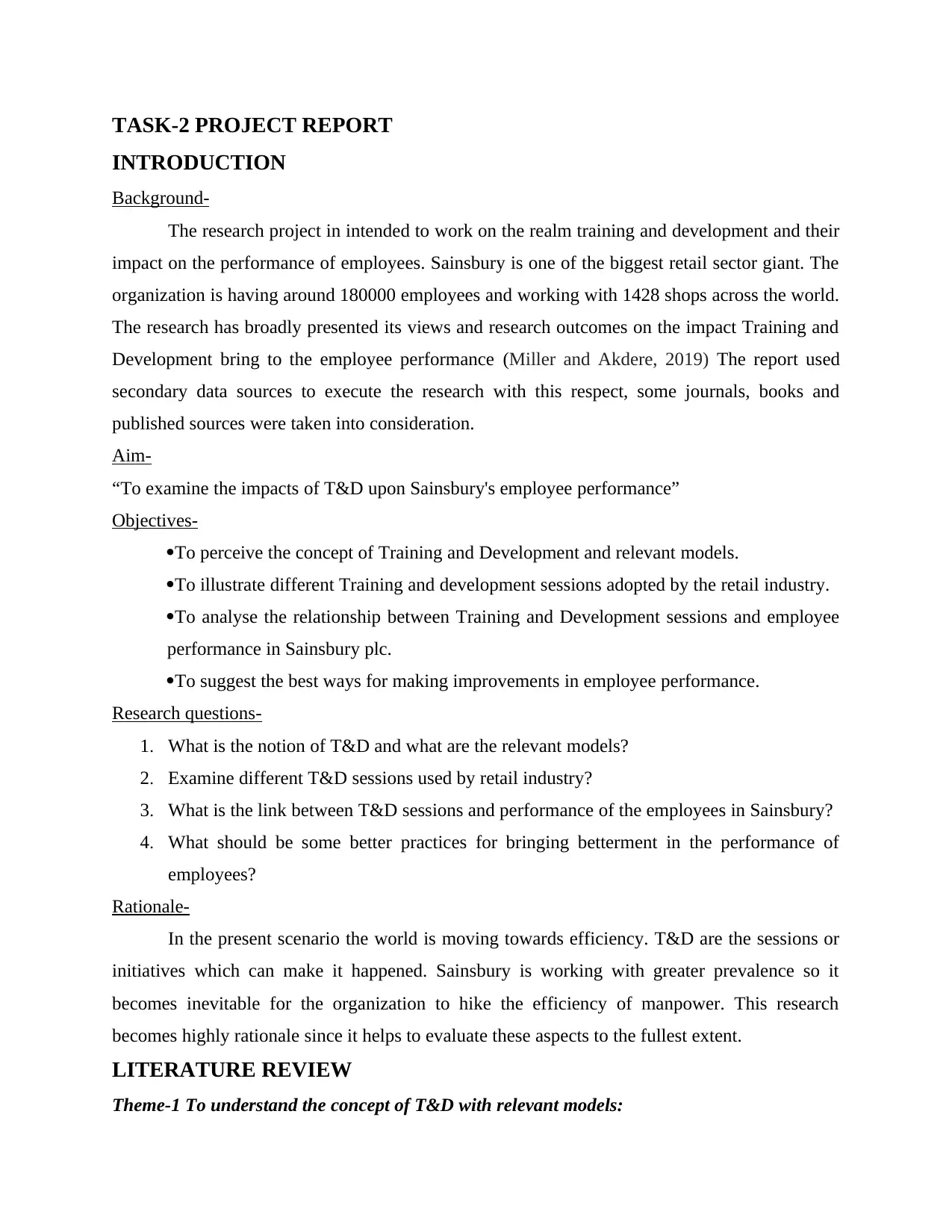
TASK-2 PROJECT REPORT
INTRODUCTION
Background-
The research project in intended to work on the realm training and development and their
impact on the performance of employees. Sainsbury is one of the biggest retail sector giant. The
organization is having around 180000 employees and working with 1428 shops across the world.
The research has broadly presented its views and research outcomes on the impact Training and
Development bring to the employee performance (Miller and Akdere, 2019) The report used
secondary data sources to execute the research with this respect, some journals, books and
published sources were taken into consideration.
Aim-
“To examine the impacts of T&D upon Sainsbury's employee performance”
Objectives-
To perceive the concept of Training and Development and relevant models.
To illustrate different Training and development sessions adopted by the retail industry.
To analyse the relationship between Training and Development sessions and employee
performance in Sainsbury plc.
To suggest the best ways for making improvements in employee performance.
Research questions-
1. What is the notion of T&D and what are the relevant models?
2. Examine different T&D sessions used by retail industry?
3. What is the link between T&D sessions and performance of the employees in Sainsbury?
4. What should be some better practices for bringing betterment in the performance of
employees?
Rationale-
In the present scenario the world is moving towards efficiency. T&D are the sessions or
initiatives which can make it happened. Sainsbury is working with greater prevalence so it
becomes inevitable for the organization to hike the efficiency of manpower. This research
becomes highly rationale since it helps to evaluate these aspects to the fullest extent.
LITERATURE REVIEW
Theme-1 To understand the concept of T&D with relevant models:
INTRODUCTION
Background-
The research project in intended to work on the realm training and development and their
impact on the performance of employees. Sainsbury is one of the biggest retail sector giant. The
organization is having around 180000 employees and working with 1428 shops across the world.
The research has broadly presented its views and research outcomes on the impact Training and
Development bring to the employee performance (Miller and Akdere, 2019) The report used
secondary data sources to execute the research with this respect, some journals, books and
published sources were taken into consideration.
Aim-
“To examine the impacts of T&D upon Sainsbury's employee performance”
Objectives-
To perceive the concept of Training and Development and relevant models.
To illustrate different Training and development sessions adopted by the retail industry.
To analyse the relationship between Training and Development sessions and employee
performance in Sainsbury plc.
To suggest the best ways for making improvements in employee performance.
Research questions-
1. What is the notion of T&D and what are the relevant models?
2. Examine different T&D sessions used by retail industry?
3. What is the link between T&D sessions and performance of the employees in Sainsbury?
4. What should be some better practices for bringing betterment in the performance of
employees?
Rationale-
In the present scenario the world is moving towards efficiency. T&D are the sessions or
initiatives which can make it happened. Sainsbury is working with greater prevalence so it
becomes inevitable for the organization to hike the efficiency of manpower. This research
becomes highly rationale since it helps to evaluate these aspects to the fullest extent.
LITERATURE REVIEW
Theme-1 To understand the concept of T&D with relevant models:
⊘ This is a preview!⊘
Do you want full access?
Subscribe today to unlock all pages.

Trusted by 1+ million students worldwide
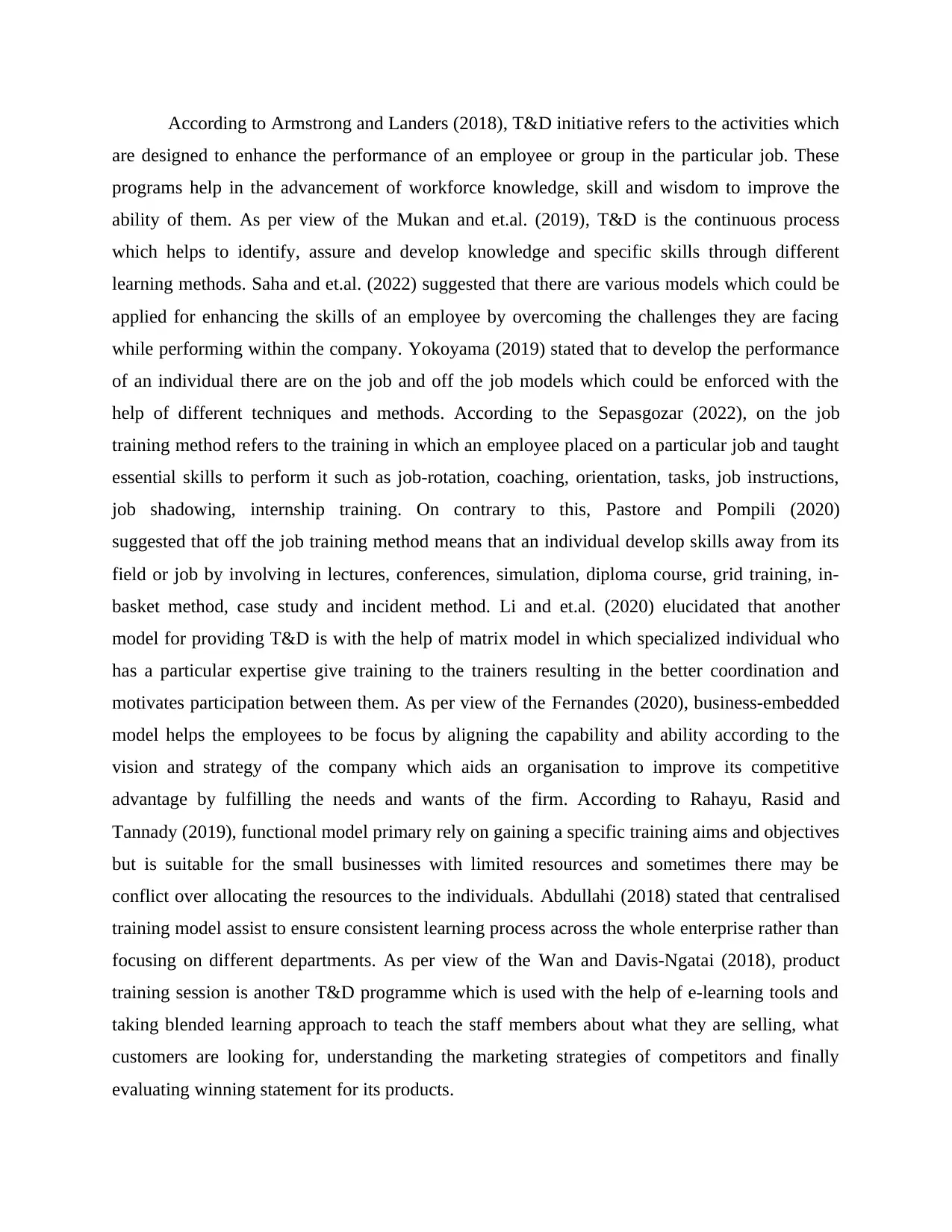
According to Armstrong and Landers (2018), T&D initiative refers to the activities which
are designed to enhance the performance of an employee or group in the particular job. These
programs help in the advancement of workforce knowledge, skill and wisdom to improve the
ability of them. As per view of the Mukan and et.al. (2019), T&D is the continuous process
which helps to identify, assure and develop knowledge and specific skills through different
learning methods. Saha and et.al. (2022) suggested that there are various models which could be
applied for enhancing the skills of an employee by overcoming the challenges they are facing
while performing within the company. Yokoyama (2019) stated that to develop the performance
of an individual there are on the job and off the job models which could be enforced with the
help of different techniques and methods. According to the Sepasgozar (2022), on the job
training method refers to the training in which an employee placed on a particular job and taught
essential skills to perform it such as job-rotation, coaching, orientation, tasks, job instructions,
job shadowing, internship training. On contrary to this, Pastore and Pompili (2020)
suggested that off the job training method means that an individual develop skills away from its
field or job by involving in lectures, conferences, simulation, diploma course, grid training, in-
basket method, case study and incident method. Li and et.al. (2020) elucidated that another
model for providing T&D is with the help of matrix model in which specialized individual who
has a particular expertise give training to the trainers resulting in the better coordination and
motivates participation between them. As per view of the Fernandes (2020), business-embedded
model helps the employees to be focus by aligning the capability and ability according to the
vision and strategy of the company which aids an organisation to improve its competitive
advantage by fulfilling the needs and wants of the firm. According to Rahayu, Rasid and
Tannady (2019), functional model primary rely on gaining a specific training aims and objectives
but is suitable for the small businesses with limited resources and sometimes there may be
conflict over allocating the resources to the individuals. Abdullahi (2018) stated that centralised
training model assist to ensure consistent learning process across the whole enterprise rather than
focusing on different departments. As per view of the Wan and Davis-Ngatai (2018), product
training session is another T&D programme which is used with the help of e-learning tools and
taking blended learning approach to teach the staff members about what they are selling, what
customers are looking for, understanding the marketing strategies of competitors and finally
evaluating winning statement for its products.
are designed to enhance the performance of an employee or group in the particular job. These
programs help in the advancement of workforce knowledge, skill and wisdom to improve the
ability of them. As per view of the Mukan and et.al. (2019), T&D is the continuous process
which helps to identify, assure and develop knowledge and specific skills through different
learning methods. Saha and et.al. (2022) suggested that there are various models which could be
applied for enhancing the skills of an employee by overcoming the challenges they are facing
while performing within the company. Yokoyama (2019) stated that to develop the performance
of an individual there are on the job and off the job models which could be enforced with the
help of different techniques and methods. According to the Sepasgozar (2022), on the job
training method refers to the training in which an employee placed on a particular job and taught
essential skills to perform it such as job-rotation, coaching, orientation, tasks, job instructions,
job shadowing, internship training. On contrary to this, Pastore and Pompili (2020)
suggested that off the job training method means that an individual develop skills away from its
field or job by involving in lectures, conferences, simulation, diploma course, grid training, in-
basket method, case study and incident method. Li and et.al. (2020) elucidated that another
model for providing T&D is with the help of matrix model in which specialized individual who
has a particular expertise give training to the trainers resulting in the better coordination and
motivates participation between them. As per view of the Fernandes (2020), business-embedded
model helps the employees to be focus by aligning the capability and ability according to the
vision and strategy of the company which aids an organisation to improve its competitive
advantage by fulfilling the needs and wants of the firm. According to Rahayu, Rasid and
Tannady (2019), functional model primary rely on gaining a specific training aims and objectives
but is suitable for the small businesses with limited resources and sometimes there may be
conflict over allocating the resources to the individuals. Abdullahi (2018) stated that centralised
training model assist to ensure consistent learning process across the whole enterprise rather than
focusing on different departments. As per view of the Wan and Davis-Ngatai (2018), product
training session is another T&D programme which is used with the help of e-learning tools and
taking blended learning approach to teach the staff members about what they are selling, what
customers are looking for, understanding the marketing strategies of competitors and finally
evaluating winning statement for its products.
Paraphrase This Document
Need a fresh take? Get an instant paraphrase of this document with our AI Paraphraser
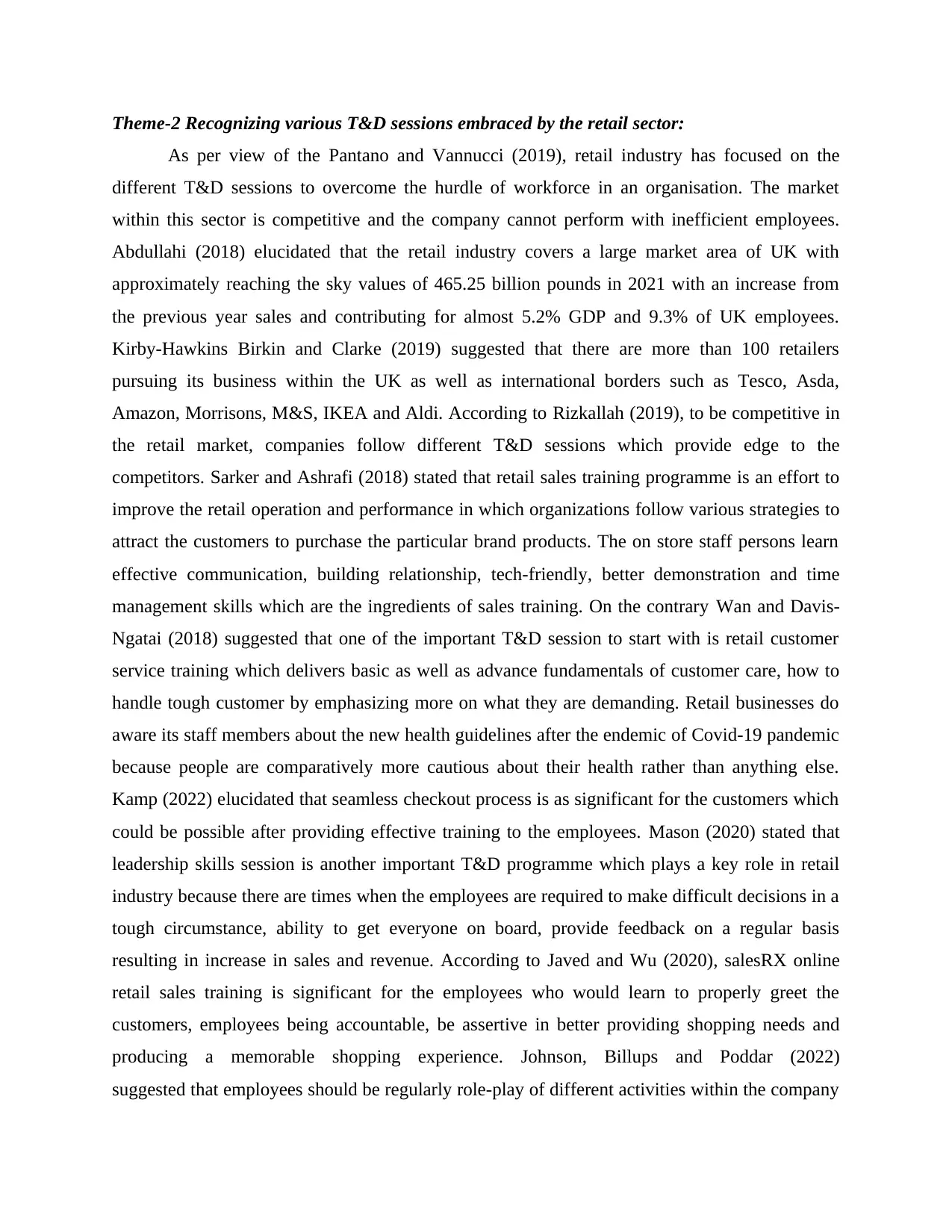
Theme-2 Recognizing various T&D sessions embraced by the retail sector:
As per view of the Pantano and Vannucci (2019), retail industry has focused on the
different T&D sessions to overcome the hurdle of workforce in an organisation. The market
within this sector is competitive and the company cannot perform with inefficient employees.
Abdullahi (2018) elucidated that the retail industry covers a large market area of UK with
approximately reaching the sky values of 465.25 billion pounds in 2021 with an increase from
the previous year sales and contributing for almost 5.2% GDP and 9.3% of UK employees.
Kirby-Hawkins Birkin and Clarke (2019) suggested that there are more than 100 retailers
pursuing its business within the UK as well as international borders such as Tesco, Asda,
Amazon, Morrisons, M&S, IKEA and Aldi. According to Rizkallah (2019), to be competitive in
the retail market, companies follow different T&D sessions which provide edge to the
competitors. Sarker and Ashrafi (2018) stated that retail sales training programme is an effort to
improve the retail operation and performance in which organizations follow various strategies to
attract the customers to purchase the particular brand products. The on store staff persons learn
effective communication, building relationship, tech-friendly, better demonstration and time
management skills which are the ingredients of sales training. On the contrary Wan and Davis-
Ngatai (2018) suggested that one of the important T&D session to start with is retail customer
service training which delivers basic as well as advance fundamentals of customer care, how to
handle tough customer by emphasizing more on what they are demanding. Retail businesses do
aware its staff members about the new health guidelines after the endemic of Covid-19 pandemic
because people are comparatively more cautious about their health rather than anything else.
Kamp (2022) elucidated that seamless checkout process is as significant for the customers which
could be possible after providing effective training to the employees. Mason (2020) stated that
leadership skills session is another important T&D programme which plays a key role in retail
industry because there are times when the employees are required to make difficult decisions in a
tough circumstance, ability to get everyone on board, provide feedback on a regular basis
resulting in increase in sales and revenue. According to Javed and Wu (2020), salesRX online
retail sales training is significant for the employees who would learn to properly greet the
customers, employees being accountable, be assertive in better providing shopping needs and
producing a memorable shopping experience. Johnson, Billups and Poddar (2022)
suggested that employees should be regularly role-play of different activities within the company
As per view of the Pantano and Vannucci (2019), retail industry has focused on the
different T&D sessions to overcome the hurdle of workforce in an organisation. The market
within this sector is competitive and the company cannot perform with inefficient employees.
Abdullahi (2018) elucidated that the retail industry covers a large market area of UK with
approximately reaching the sky values of 465.25 billion pounds in 2021 with an increase from
the previous year sales and contributing for almost 5.2% GDP and 9.3% of UK employees.
Kirby-Hawkins Birkin and Clarke (2019) suggested that there are more than 100 retailers
pursuing its business within the UK as well as international borders such as Tesco, Asda,
Amazon, Morrisons, M&S, IKEA and Aldi. According to Rizkallah (2019), to be competitive in
the retail market, companies follow different T&D sessions which provide edge to the
competitors. Sarker and Ashrafi (2018) stated that retail sales training programme is an effort to
improve the retail operation and performance in which organizations follow various strategies to
attract the customers to purchase the particular brand products. The on store staff persons learn
effective communication, building relationship, tech-friendly, better demonstration and time
management skills which are the ingredients of sales training. On the contrary Wan and Davis-
Ngatai (2018) suggested that one of the important T&D session to start with is retail customer
service training which delivers basic as well as advance fundamentals of customer care, how to
handle tough customer by emphasizing more on what they are demanding. Retail businesses do
aware its staff members about the new health guidelines after the endemic of Covid-19 pandemic
because people are comparatively more cautious about their health rather than anything else.
Kamp (2022) elucidated that seamless checkout process is as significant for the customers which
could be possible after providing effective training to the employees. Mason (2020) stated that
leadership skills session is another important T&D programme which plays a key role in retail
industry because there are times when the employees are required to make difficult decisions in a
tough circumstance, ability to get everyone on board, provide feedback on a regular basis
resulting in increase in sales and revenue. According to Javed and Wu (2020), salesRX online
retail sales training is significant for the employees who would learn to properly greet the
customers, employees being accountable, be assertive in better providing shopping needs and
producing a memorable shopping experience. Johnson, Billups and Poddar (2022)
suggested that employees should be regularly role-play of different activities within the company
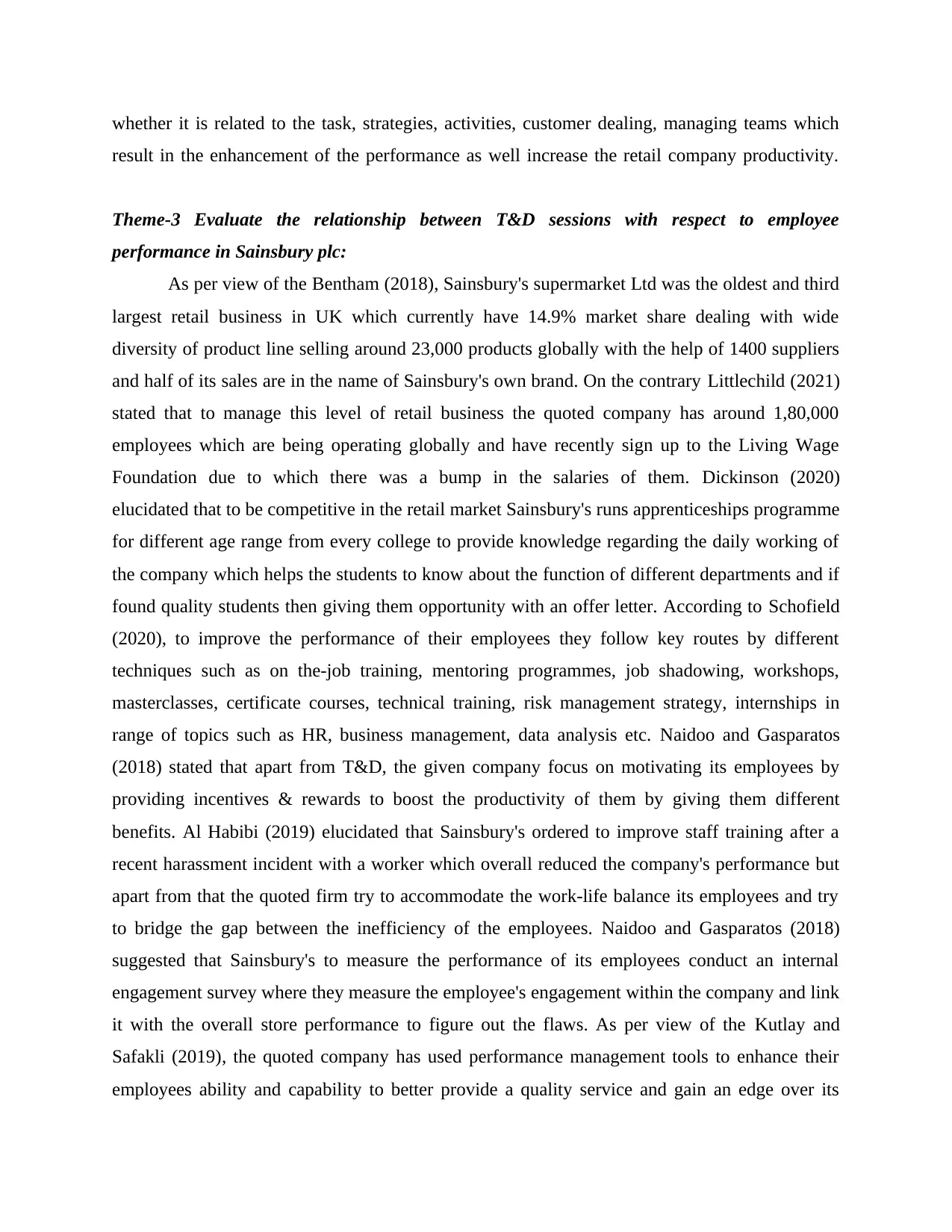
whether it is related to the task, strategies, activities, customer dealing, managing teams which
result in the enhancement of the performance as well increase the retail company productivity.
Theme-3 Evaluate the relationship between T&D sessions with respect to employee
performance in Sainsbury plc:
As per view of the Bentham (2018), Sainsbury's supermarket Ltd was the oldest and third
largest retail business in UK which currently have 14.9% market share dealing with wide
diversity of product line selling around 23,000 products globally with the help of 1400 suppliers
and half of its sales are in the name of Sainsbury's own brand. On the contrary Littlechild (2021)
stated that to manage this level of retail business the quoted company has around 1,80,000
employees which are being operating globally and have recently sign up to the Living Wage
Foundation due to which there was a bump in the salaries of them. Dickinson (2020)
elucidated that to be competitive in the retail market Sainsbury's runs apprenticeships programme
for different age range from every college to provide knowledge regarding the daily working of
the company which helps the students to know about the function of different departments and if
found quality students then giving them opportunity with an offer letter. According to Schofield
(2020), to improve the performance of their employees they follow key routes by different
techniques such as on the-job training, mentoring programmes, job shadowing, workshops,
masterclasses, certificate courses, technical training, risk management strategy, internships in
range of topics such as HR, business management, data analysis etc. Naidoo and Gasparatos
(2018) stated that apart from T&D, the given company focus on motivating its employees by
providing incentives & rewards to boost the productivity of them by giving them different
benefits. Al Habibi (2019) elucidated that Sainsbury's ordered to improve staff training after a
recent harassment incident with a worker which overall reduced the company's performance but
apart from that the quoted firm try to accommodate the work-life balance its employees and try
to bridge the gap between the inefficiency of the employees. Naidoo and Gasparatos (2018)
suggested that Sainsbury's to measure the performance of its employees conduct an internal
engagement survey where they measure the employee's engagement within the company and link
it with the overall store performance to figure out the flaws. As per view of the Kutlay and
Safakli (2019), the quoted company has used performance management tools to enhance their
employees ability and capability to better provide a quality service and gain an edge over its
result in the enhancement of the performance as well increase the retail company productivity.
Theme-3 Evaluate the relationship between T&D sessions with respect to employee
performance in Sainsbury plc:
As per view of the Bentham (2018), Sainsbury's supermarket Ltd was the oldest and third
largest retail business in UK which currently have 14.9% market share dealing with wide
diversity of product line selling around 23,000 products globally with the help of 1400 suppliers
and half of its sales are in the name of Sainsbury's own brand. On the contrary Littlechild (2021)
stated that to manage this level of retail business the quoted company has around 1,80,000
employees which are being operating globally and have recently sign up to the Living Wage
Foundation due to which there was a bump in the salaries of them. Dickinson (2020)
elucidated that to be competitive in the retail market Sainsbury's runs apprenticeships programme
for different age range from every college to provide knowledge regarding the daily working of
the company which helps the students to know about the function of different departments and if
found quality students then giving them opportunity with an offer letter. According to Schofield
(2020), to improve the performance of their employees they follow key routes by different
techniques such as on the-job training, mentoring programmes, job shadowing, workshops,
masterclasses, certificate courses, technical training, risk management strategy, internships in
range of topics such as HR, business management, data analysis etc. Naidoo and Gasparatos
(2018) stated that apart from T&D, the given company focus on motivating its employees by
providing incentives & rewards to boost the productivity of them by giving them different
benefits. Al Habibi (2019) elucidated that Sainsbury's ordered to improve staff training after a
recent harassment incident with a worker which overall reduced the company's performance but
apart from that the quoted firm try to accommodate the work-life balance its employees and try
to bridge the gap between the inefficiency of the employees. Naidoo and Gasparatos (2018)
suggested that Sainsbury's to measure the performance of its employees conduct an internal
engagement survey where they measure the employee's engagement within the company and link
it with the overall store performance to figure out the flaws. As per view of the Kutlay and
Safakli (2019), the quoted company has used performance management tools to enhance their
employees ability and capability to better provide a quality service and gain an edge over its
⊘ This is a preview!⊘
Do you want full access?
Subscribe today to unlock all pages.

Trusted by 1+ million students worldwide
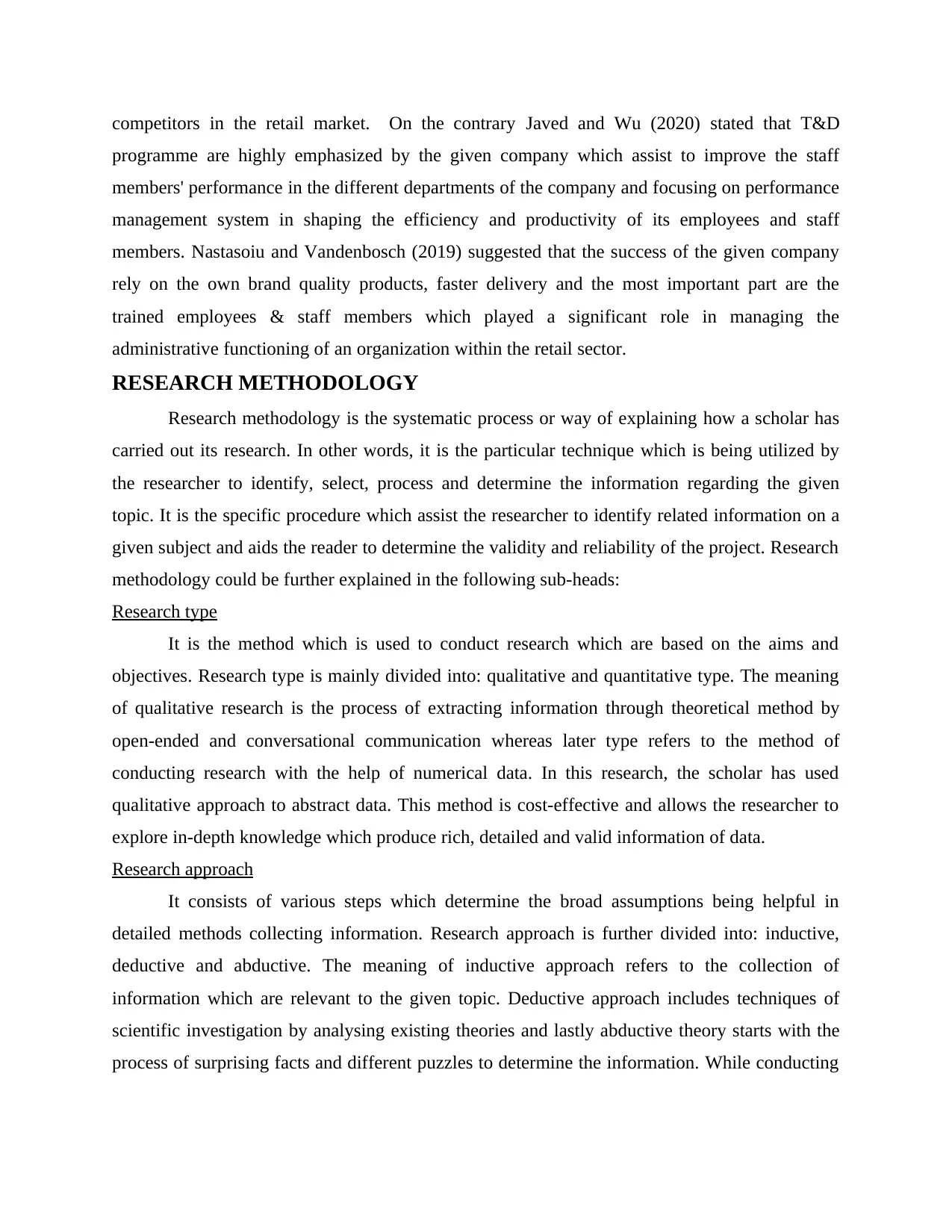
competitors in the retail market. On the contrary Javed and Wu (2020) stated that T&D
programme are highly emphasized by the given company which assist to improve the staff
members' performance in the different departments of the company and focusing on performance
management system in shaping the efficiency and productivity of its employees and staff
members. Nastasoiu and Vandenbosch (2019) suggested that the success of the given company
rely on the own brand quality products, faster delivery and the most important part are the
trained employees & staff members which played a significant role in managing the
administrative functioning of an organization within the retail sector.
RESEARCH METHODOLOGY
Research methodology is the systematic process or way of explaining how a scholar has
carried out its research. In other words, it is the particular technique which is being utilized by
the researcher to identify, select, process and determine the information regarding the given
topic. It is the specific procedure which assist the researcher to identify related information on a
given subject and aids the reader to determine the validity and reliability of the project. Research
methodology could be further explained in the following sub-heads:
Research type
It is the method which is used to conduct research which are based on the aims and
objectives. Research type is mainly divided into: qualitative and quantitative type. The meaning
of qualitative research is the process of extracting information through theoretical method by
open-ended and conversational communication whereas later type refers to the method of
conducting research with the help of numerical data. In this research, the scholar has used
qualitative approach to abstract data. This method is cost-effective and allows the researcher to
explore in-depth knowledge which produce rich, detailed and valid information of data.
Research approach
It consists of various steps which determine the broad assumptions being helpful in
detailed methods collecting information. Research approach is further divided into: inductive,
deductive and abductive. The meaning of inductive approach refers to the collection of
information which are relevant to the given topic. Deductive approach includes techniques of
scientific investigation by analysing existing theories and lastly abductive theory starts with the
process of surprising facts and different puzzles to determine the information. While conducting
programme are highly emphasized by the given company which assist to improve the staff
members' performance in the different departments of the company and focusing on performance
management system in shaping the efficiency and productivity of its employees and staff
members. Nastasoiu and Vandenbosch (2019) suggested that the success of the given company
rely on the own brand quality products, faster delivery and the most important part are the
trained employees & staff members which played a significant role in managing the
administrative functioning of an organization within the retail sector.
RESEARCH METHODOLOGY
Research methodology is the systematic process or way of explaining how a scholar has
carried out its research. In other words, it is the particular technique which is being utilized by
the researcher to identify, select, process and determine the information regarding the given
topic. It is the specific procedure which assist the researcher to identify related information on a
given subject and aids the reader to determine the validity and reliability of the project. Research
methodology could be further explained in the following sub-heads:
Research type
It is the method which is used to conduct research which are based on the aims and
objectives. Research type is mainly divided into: qualitative and quantitative type. The meaning
of qualitative research is the process of extracting information through theoretical method by
open-ended and conversational communication whereas later type refers to the method of
conducting research with the help of numerical data. In this research, the scholar has used
qualitative approach to abstract data. This method is cost-effective and allows the researcher to
explore in-depth knowledge which produce rich, detailed and valid information of data.
Research approach
It consists of various steps which determine the broad assumptions being helpful in
detailed methods collecting information. Research approach is further divided into: inductive,
deductive and abductive. The meaning of inductive approach refers to the collection of
information which are relevant to the given topic. Deductive approach includes techniques of
scientific investigation by analysing existing theories and lastly abductive theory starts with the
process of surprising facts and different puzzles to determine the information. While conducting
Paraphrase This Document
Need a fresh take? Get an instant paraphrase of this document with our AI Paraphraser
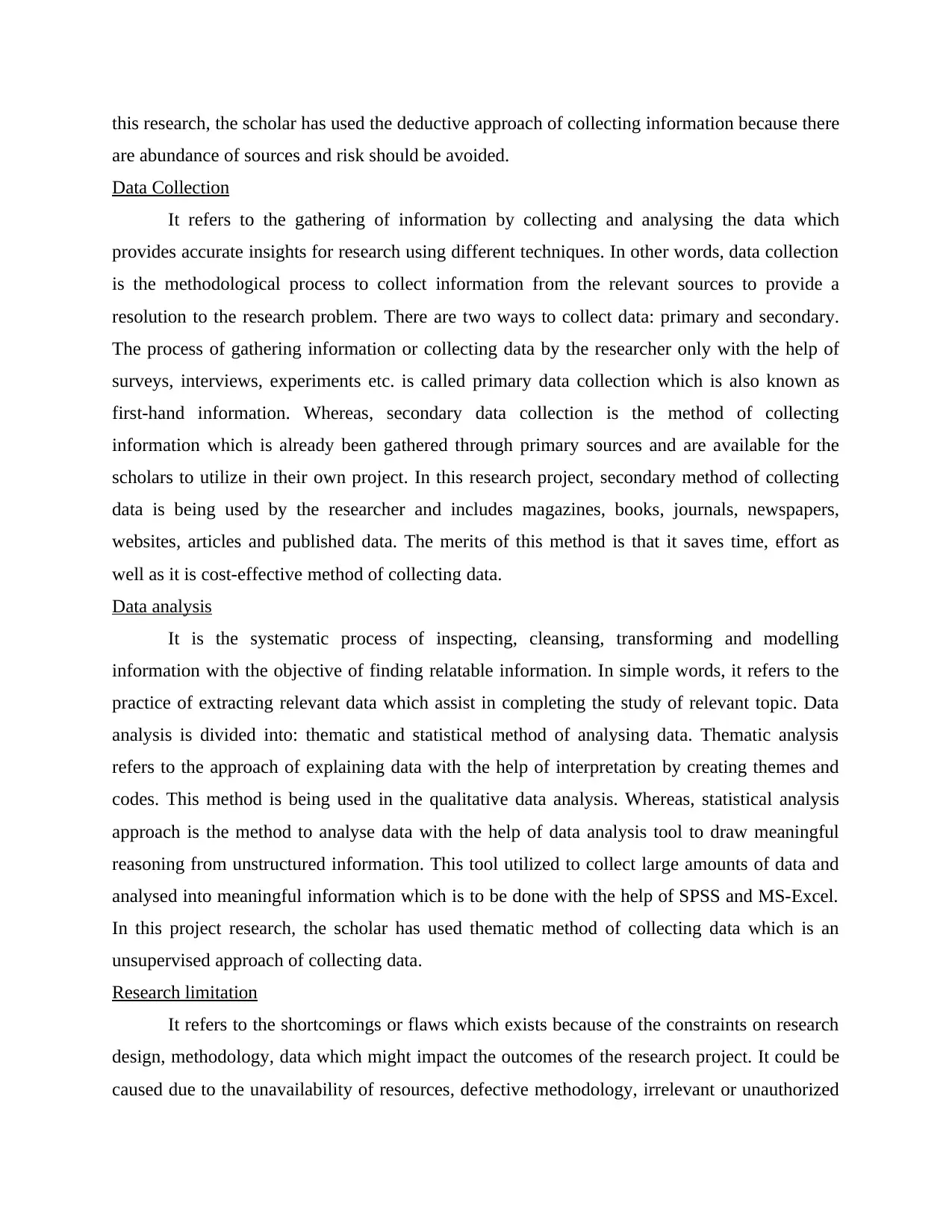
this research, the scholar has used the deductive approach of collecting information because there
are abundance of sources and risk should be avoided.
Data Collection
It refers to the gathering of information by collecting and analysing the data which
provides accurate insights for research using different techniques. In other words, data collection
is the methodological process to collect information from the relevant sources to provide a
resolution to the research problem. There are two ways to collect data: primary and secondary.
The process of gathering information or collecting data by the researcher only with the help of
surveys, interviews, experiments etc. is called primary data collection which is also known as
first-hand information. Whereas, secondary data collection is the method of collecting
information which is already been gathered through primary sources and are available for the
scholars to utilize in their own project. In this research project, secondary method of collecting
data is being used by the researcher and includes magazines, books, journals, newspapers,
websites, articles and published data. The merits of this method is that it saves time, effort as
well as it is cost-effective method of collecting data.
Data analysis
It is the systematic process of inspecting, cleansing, transforming and modelling
information with the objective of finding relatable information. In simple words, it refers to the
practice of extracting relevant data which assist in completing the study of relevant topic. Data
analysis is divided into: thematic and statistical method of analysing data. Thematic analysis
refers to the approach of explaining data with the help of interpretation by creating themes and
codes. This method is being used in the qualitative data analysis. Whereas, statistical analysis
approach is the method to analyse data with the help of data analysis tool to draw meaningful
reasoning from unstructured information. This tool utilized to collect large amounts of data and
analysed into meaningful information which is to be done with the help of SPSS and MS-Excel.
In this project research, the scholar has used thematic method of collecting data which is an
unsupervised approach of collecting data.
Research limitation
It refers to the shortcomings or flaws which exists because of the constraints on research
design, methodology, data which might impact the outcomes of the research project. It could be
caused due to the unavailability of resources, defective methodology, irrelevant or unauthorized
are abundance of sources and risk should be avoided.
Data Collection
It refers to the gathering of information by collecting and analysing the data which
provides accurate insights for research using different techniques. In other words, data collection
is the methodological process to collect information from the relevant sources to provide a
resolution to the research problem. There are two ways to collect data: primary and secondary.
The process of gathering information or collecting data by the researcher only with the help of
surveys, interviews, experiments etc. is called primary data collection which is also known as
first-hand information. Whereas, secondary data collection is the method of collecting
information which is already been gathered through primary sources and are available for the
scholars to utilize in their own project. In this research project, secondary method of collecting
data is being used by the researcher and includes magazines, books, journals, newspapers,
websites, articles and published data. The merits of this method is that it saves time, effort as
well as it is cost-effective method of collecting data.
Data analysis
It is the systematic process of inspecting, cleansing, transforming and modelling
information with the objective of finding relatable information. In simple words, it refers to the
practice of extracting relevant data which assist in completing the study of relevant topic. Data
analysis is divided into: thematic and statistical method of analysing data. Thematic analysis
refers to the approach of explaining data with the help of interpretation by creating themes and
codes. This method is being used in the qualitative data analysis. Whereas, statistical analysis
approach is the method to analyse data with the help of data analysis tool to draw meaningful
reasoning from unstructured information. This tool utilized to collect large amounts of data and
analysed into meaningful information which is to be done with the help of SPSS and MS-Excel.
In this project research, the scholar has used thematic method of collecting data which is an
unsupervised approach of collecting data.
Research limitation
It refers to the shortcomings or flaws which exists because of the constraints on research
design, methodology, data which might impact the outcomes of the research project. It could be
caused due to the unavailability of resources, defective methodology, irrelevant or unauthorized
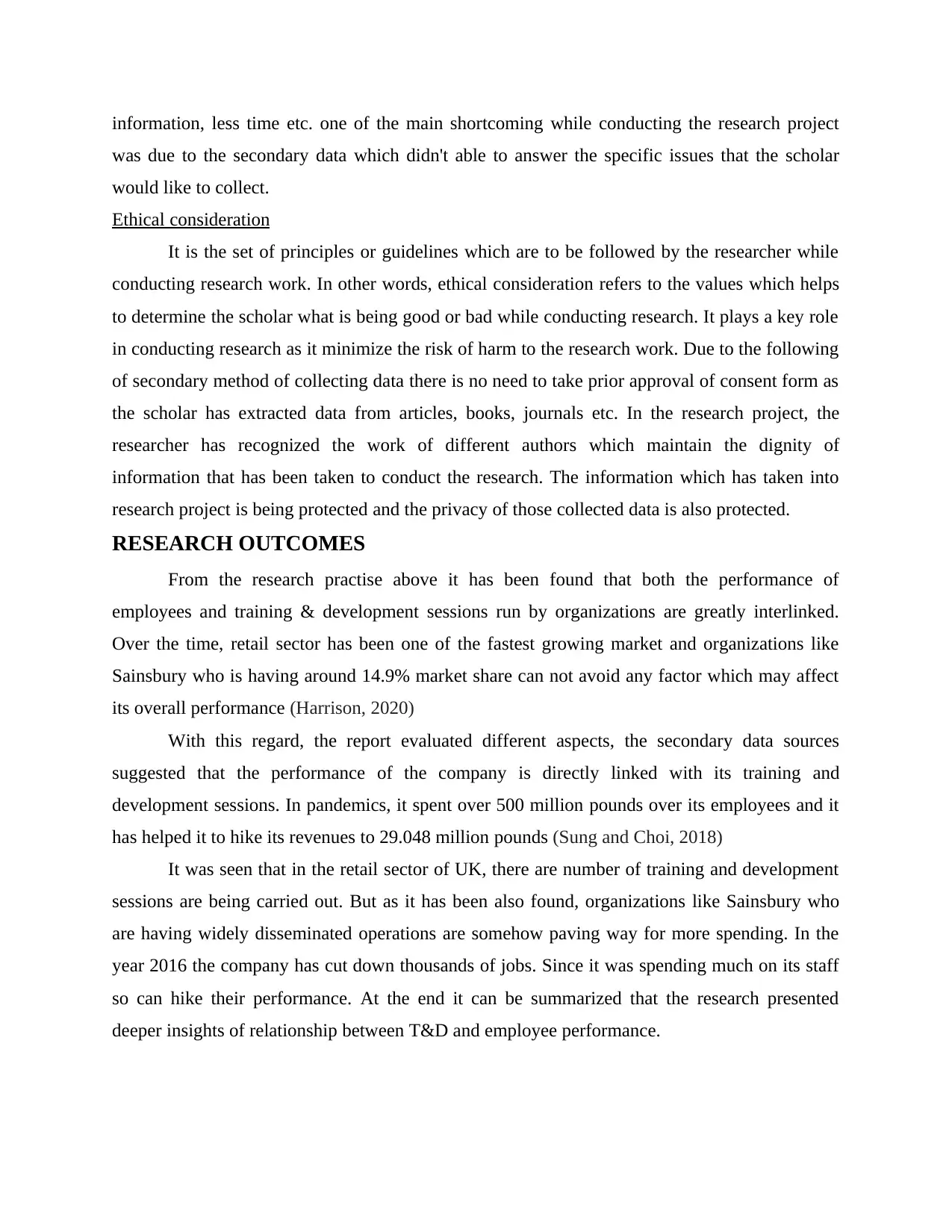
information, less time etc. one of the main shortcoming while conducting the research project
was due to the secondary data which didn't able to answer the specific issues that the scholar
would like to collect.
Ethical consideration
It is the set of principles or guidelines which are to be followed by the researcher while
conducting research work. In other words, ethical consideration refers to the values which helps
to determine the scholar what is being good or bad while conducting research. It plays a key role
in conducting research as it minimize the risk of harm to the research work. Due to the following
of secondary method of collecting data there is no need to take prior approval of consent form as
the scholar has extracted data from articles, books, journals etc. In the research project, the
researcher has recognized the work of different authors which maintain the dignity of
information that has been taken to conduct the research. The information which has taken into
research project is being protected and the privacy of those collected data is also protected.
RESEARCH OUTCOMES
From the research practise above it has been found that both the performance of
employees and training & development sessions run by organizations are greatly interlinked.
Over the time, retail sector has been one of the fastest growing market and organizations like
Sainsbury who is having around 14.9% market share can not avoid any factor which may affect
its overall performance (Harrison, 2020)
With this regard, the report evaluated different aspects, the secondary data sources
suggested that the performance of the company is directly linked with its training and
development sessions. In pandemics, it spent over 500 million pounds over its employees and it
has helped it to hike its revenues to 29.048 million pounds (Sung and Choi, 2018)
It was seen that in the retail sector of UK, there are number of training and development
sessions are being carried out. But as it has been also found, organizations like Sainsbury who
are having widely disseminated operations are somehow paving way for more spending. In the
year 2016 the company has cut down thousands of jobs. Since it was spending much on its staff
so can hike their performance. At the end it can be summarized that the research presented
deeper insights of relationship between T&D and employee performance.
was due to the secondary data which didn't able to answer the specific issues that the scholar
would like to collect.
Ethical consideration
It is the set of principles or guidelines which are to be followed by the researcher while
conducting research work. In other words, ethical consideration refers to the values which helps
to determine the scholar what is being good or bad while conducting research. It plays a key role
in conducting research as it minimize the risk of harm to the research work. Due to the following
of secondary method of collecting data there is no need to take prior approval of consent form as
the scholar has extracted data from articles, books, journals etc. In the research project, the
researcher has recognized the work of different authors which maintain the dignity of
information that has been taken to conduct the research. The information which has taken into
research project is being protected and the privacy of those collected data is also protected.
RESEARCH OUTCOMES
From the research practise above it has been found that both the performance of
employees and training & development sessions run by organizations are greatly interlinked.
Over the time, retail sector has been one of the fastest growing market and organizations like
Sainsbury who is having around 14.9% market share can not avoid any factor which may affect
its overall performance (Harrison, 2020)
With this regard, the report evaluated different aspects, the secondary data sources
suggested that the performance of the company is directly linked with its training and
development sessions. In pandemics, it spent over 500 million pounds over its employees and it
has helped it to hike its revenues to 29.048 million pounds (Sung and Choi, 2018)
It was seen that in the retail sector of UK, there are number of training and development
sessions are being carried out. But as it has been also found, organizations like Sainsbury who
are having widely disseminated operations are somehow paving way for more spending. In the
year 2016 the company has cut down thousands of jobs. Since it was spending much on its staff
so can hike their performance. At the end it can be summarized that the research presented
deeper insights of relationship between T&D and employee performance.
⊘ This is a preview!⊘
Do you want full access?
Subscribe today to unlock all pages.

Trusted by 1+ million students worldwide
1 out of 17
Related Documents
Your All-in-One AI-Powered Toolkit for Academic Success.
+13062052269
info@desklib.com
Available 24*7 on WhatsApp / Email
![[object Object]](/_next/static/media/star-bottom.7253800d.svg)
Unlock your academic potential
Copyright © 2020–2025 A2Z Services. All Rights Reserved. Developed and managed by ZUCOL.





